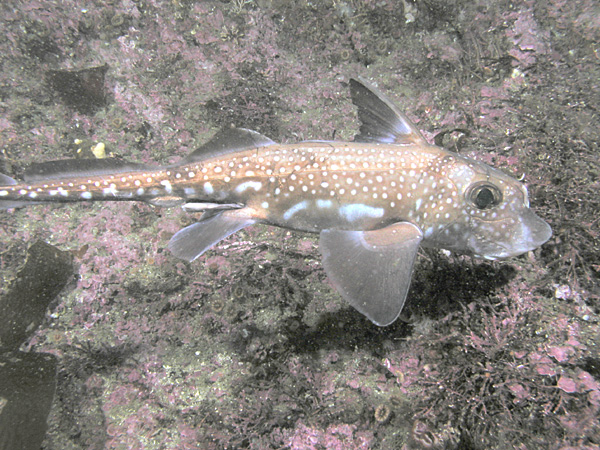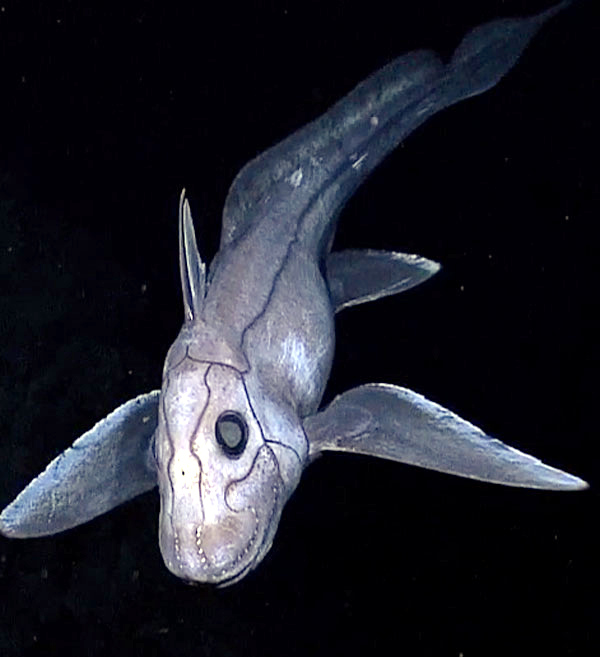|
Spotted Ratfish
The spotted ratfish (''Hydrolagus colliei'') is a chimaera found in the north-eastern Pacific Ocean. Often seen by divers at night in the Pacific Northwest, this cartilaginous fish gets its characteristic name from a pointed rat-like tail. The ratfish lays leathery egg cases on the bottom of muddy or sandy areas, which are often mistaken by divers as something inanimate. While mainly a deep-water species, it occurs at shallower depths in the northern part of its range. The generic name, ''Hydrolagus'', comes from the Greek words ὕδωρ, meaning water,Liddell, H.G. & Scott, R. (1940). ''A Greek-English Lexicon. revised and augmented throughout by Sir Henry Stuart Jones. with the assistance of. Roderick McKenzie.'' Oxford: Clarendon Press. and λαγώς/λαγῶς, meaning hare, and the specific name honors Alexander Collie, who was a ship surgeon and early naturalist. The spotted ratfish is common in much of its range, not typically eaten by humans, and is not commercially c ... [...More Info...] [...Related Items...] OR: [Wikipedia] [Google] [Baidu] |
George Tradescant Lay
George Tradescant Lay (c. 1800 – 6 November 1845) was a British naturalist, missionary and diplomat. Lay was a naturalist on the English sailing ship HMS ''Blossom'' under the command of Captain Frederick William Beechey from 1825 to 1828, where he collected specimens in the Pacific including California, Alaska, Kamchatka, China, Mexico, South America, and Hawaii, and other South Pacific islands. He is credited as being one of the discoverers of the flower ''Layia gaillardioides'', as a result having the genus ''Layia'' named for him. He then went on to become a missionary in China for the British and Foreign Bible Society from 1836 to 1839. During this time, he studied the Chinese language and culture. Upon returning to England in 1839, his experience in China helped him obtain a position of British Consul in China. He was posted in Canton in 1843, then Foochow in 1844, and finally Amoy in 1845, before dying later that year from a fever. His son, Horatio Nelson Lay follo ... [...More Info...] [...Related Items...] OR: [Wikipedia] [Google] [Baidu] |
Elasmobranchii
Elasmobranchii () is a subclass of Chondrichthyes or cartilaginous fish, including sharks (superorder Selachii), rays, skates, and sawfish (superorder Batoidea). Members of this subclass are characterised by having five to seven pairs of gill clefts opening individually to the exterior, rigid dorsal fins and small placoid scales on the skin. The teeth are in several series; the upper jaw is not fused to the cranium, and the lower jaw is articulated with the upper. The details of this jaw anatomy vary between species, and help distinguish the different elasmobranch clades. The pelvic fins in males are modified to create claspers for the transfer of sperm. There is no swim bladder; instead, these fish maintain buoyancy with large livers rich in oil. The definition of the clade is unclear with respect to fossil chondrichthyans. It has been used by different authors as equivalent to Neoselachii (the clade including modern sharks and rays and their last common ancestor) or for al ... [...More Info...] [...Related Items...] OR: [Wikipedia] [Google] [Baidu] |
Soupfin Shark
The school shark (''Galeorhinus galeus'') is a houndshark of the Family (biology), family Triakidae, and the only member of the genus ''Galeorhinus''. Common names also include tope, tope shark, snapper shark, and soupfin shark. It is found worldwide in temperate seas at depths down to about . It can grow to nearly long. It feeds both in midwater and near the seabed, and its reproduction is ovoviviparous. This shark is caught in Fishery, fisheries for its flesh, its fins, and its liver, which has a very high vitamin A content. The IUCN has classified this species as critically endangered in its Red List of Threatened Species. Description The school shark is a small, shallow-bodied shark with an elongated snout. The large mouth is crescent-shaped and the teeth are of a similar size and shape in both jaws. They are triangular-shaped, small, and flat, set at an oblique angle facing backwards, serrated and with a notch. The spiracles are small. The first dorsal fin is triangular with ... [...More Info...] [...Related Items...] OR: [Wikipedia] [Google] [Baidu] |
Clams
Clam is a common name for several kinds of bivalve molluscs. The word is often applied only to those that are edible and live as infauna, spending most of their lives halfway buried in the sand of the seafloor or riverbeds. Clams have two shells of equal size connected by two adductor muscles and have a powerful burrowing foot. They live in both freshwater and marine environments; in salt water they prefer to burrow down into the mud and the turbidity of the water required varies with species and location; the greatest diversity of these is in North America. Clams in the culinary sense do not live attached to a substrate (whereas oysters and mussels do) and do not live near the bottom (whereas scallops do). In culinary usage, clams are commonly eaten marine bivalves, as in clam digging and the resulting soup, clam chowder. Many edible clams such as palourde clams are ovoid or triangular; however, razor clams have an elongated parallel-sided shell, suggesting an old-fashioned s ... [...More Info...] [...Related Items...] OR: [Wikipedia] [Google] [Baidu] |
Crabs
Crabs are decapod crustaceans of the infraorder Brachyura, which typically have a very short projecting "tail" (abdomen) ( el, βραχύς , translit=brachys = short, / = tail), usually hidden entirely under the thorax. They live in all the world's oceans, in freshwater, and on land, are generally covered with a thick exoskeleton, and have a single pair of pincers. They first appeared during the Jurassic Period. Description Crabs are generally covered with a thick exoskeleton, composed primarily of highly mineralized chitin, and armed with a pair of chelae (claws). Crabs vary in size from the pea crab, a few millimeters wide, to the Japanese spider crab, with a leg span up to . Several other groups of crustaceans with similar appearances – such as king crabs and porcelain crabs – are not true crabs, but have evolved features similar to true crabs through a process known as carcinisation. Environment Crabs are found in all of the world's oceans, as well as in fresh w ... [...More Info...] [...Related Items...] OR: [Wikipedia] [Google] [Baidu] |
Public Aquaria
A public aquarium (plural: ''public aquaria'' or ''public Water Zoo'') is the aquatic counterpart of a zoo, which houses living aquatic animal and plant specimens for public viewing. Most public aquariums feature tanks larger than those kept by home aquarists, as well as smaller tanks. Since the first public aquariums were built in the mid-19th century, they have become popular and their numbers have increased. Most modern accredited aquariums stress conservation issues and educating the public.Visitor Impact accessed 3 February 2007. History [...More Info...] [...Related Items...] OR: [Wikipedia] [Google] [Baidu] |
Chimaera
Chimaeras are cartilaginous fish in the order Chimaeriformes , known informally as ghost sharks, rat fish, spookfish, or rabbit fish; the last three names are not to be confused with rattails, Opisthoproctidae, or Siganidae, respectively. At one time a "diverse and abundant" group (based on the fossil record), their closest living relatives are sharks and rays, though their last common ancestor with them lived nearly 400 million years ago. Today, they are largely confined to deep water. Description and habits Chimaeras live in temperate ocean floors down to deep, with few occurring at depths shallower than . Exceptions include the members of the genus ''Callorhinchus'', the rabbit fish and the spotted ratfish, which locally or periodically can be found at shallower depths. Consequently, these are also among the few species from the chimaera order kept in public aquaria. They live in all the oceans except for the Arctic and Antarctic oceans. They have elongated, soft ... [...More Info...] [...Related Items...] OR: [Wikipedia] [Google] [Baidu] |
Gulf Of California
The Gulf of California ( es, Golfo de California), also known as the Sea of Cortés (''Mar de Cortés'') or Sea of Cortez, or less commonly as the Vermilion Sea (''Mar Bermejo''), is a marginal sea of the Pacific Ocean that separates the Baja California Peninsula from the Mexico, Mexican mainland. It is bordered by the states of Baja California, Baja California Sur, Sonora, and Sinaloa with a coastline of approximately . Rivers that flow into the Gulf of California include the Colorado River, Colorado, Fuerte River, Fuerte, Mayo River (Mexico), Mayo, Sinaloa River, Sinaloa, Sonora River, Sonora, and the Yaqui River, Yaqui. The surface of the gulf is about . Maximum depths exceed because of the complex geology, linked to plate tectonics. The gulf is thought to be one of the most diverse seas on Earth and is home to more than 5,000 species of micro-invertebrates. Parts of the Gulf of California are a UNESCO World Heritage Site. Geography History The marine expeditions of Fortún ... [...More Info...] [...Related Items...] OR: [Wikipedia] [Google] [Baidu] |
Alaska
Alaska ( ; russian: Аляска, Alyaska; ale, Alax̂sxax̂; ; ems, Alas'kaaq; Yup'ik: ''Alaskaq''; tli, Anáaski) is a state located in the Western United States on the northwest extremity of North America. A semi-exclave of the U.S., it borders the Canadian province of British Columbia and the Yukon territory to the east; it also shares a maritime border with the Russian Federation's Chukotka Autonomous Okrug to the west, just across the Bering Strait. To the north are the Chukchi and Beaufort Seas of the Arctic Ocean, while the Pacific Ocean lies to the south and southwest. Alaska is by far the largest U.S. state by area, comprising more total area than the next three largest states (Texas, California, and Montana) combined. It represents the seventh-largest subnational division in the world. It is the third-least populous and the most sparsely populated state, but by far the continent's most populous territory located mostly north of the 60th parallel, with ... [...More Info...] [...Related Items...] OR: [Wikipedia] [Google] [Baidu] |
Hydrolagus Colliei1
''Hydrolagus'' is a genus of fish in the family Chimaeridae found in the Atlantic, Indian and Pacific Oceans.Weigmann, S. (2016)Annotated checklist of the living sharks, batoids and chimaeras (Chondrichthyes) of the world, with a focus on biogeographical diversity.''Journal of Fish Biology, 88 (3): 837-1037.'' Species The 23 recognized species in this genus are: * ''Hydrolagus affinis'' ( Brito Capello ( pt), 1868) (small-eyed rabbitfish) * ''Hydrolagus africanus'' ( Gilchrist, 1922) (African chimaera) Walovich, K.A., Ebert, D.A., Long, D.J. & Didier, D.A. (2015)Redescription of ''Hydrolagus africanus'' (Gilchrist, 1922) (Chimaeriformes: Chimaeridae), with a review of southern African chimaeroids and a key to their identification.''African Journal of Marine Science, 37 (2): 157-165.'' * ''Hydrolagus alberti'' Bigelow & Schroeder, 1951 (gulf chimaera) * ''Hydrolagus alphus'' Quaranta, Didier, Long & Ebert, 2006 (whitespot ghost shark) * ''Hydrolagus barbouri'' (Garman, 1908) ( ... [...More Info...] [...Related Items...] OR: [Wikipedia] [Google] [Baidu] |
Holocephali Skull Structures
Holocephali ("complete heads"), sometimes given the term Euchondrocephali, is a subclass of cartilaginous fish in the class Chondrichthyes. The earliest fossils are of teeth and come from the Devonian period. Little is known about these primitive forms, and the only surviving group in the subclass is the order Chimaeriformes. Chimaeriformes, commonly known as chimaeras, includes the rat fishes in the genus ''Chimaera'', and the elephant fishes in the genus ''Callorhinchus''. These fishes move by using sweeping movements of their large pectoral fins. They are deep sea fish with slender tails, living close to the seabed to feed on benthic invertebrates. They lack a stomach, their food moving directly into the intestine. Extinct holocephalans were much more diverse in lifestyles, including shark-like predatory forms and slow, durophagous fish. Characteristics Members of this taxon preserve today some features of elasmobranch life in Paleozoic times, though in other respects they ... [...More Info...] [...Related Items...] OR: [Wikipedia] [Google] [Baidu] |


.jpg)




